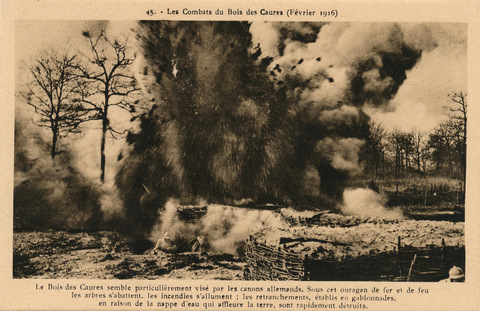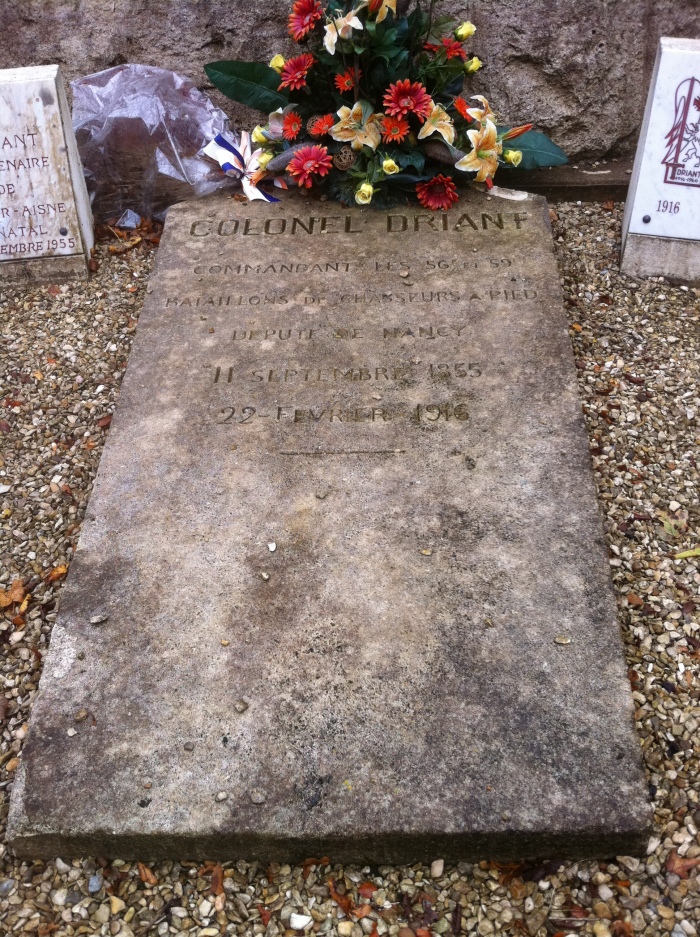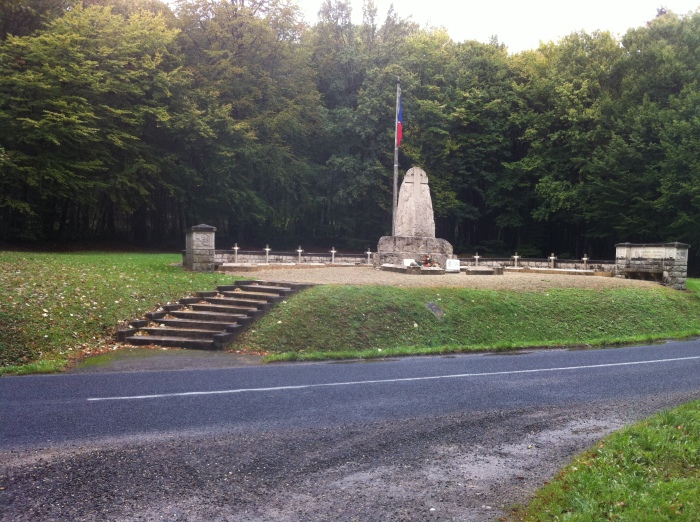The Bois des Caures
22nd February 1916

A recreated postcard of the action at the Bois des Caures which came out after Driant’s defence of the wood
At dawn, the situation in the Bois Caures worsened. There are very few French left in the Bois des Fays and the village of Beaumont to the south. Yet no new attack was initially unleashed until, at noon, a barrage opened up on the wood again and another attack began,
Sgt Quartermaster Murat of the 59th BCP,
“Around noon, the bombardment began to subside. We are ordered ‘Everybody out!’ The Chasseurs were waiting for the order to break away with no defence to protect us. Colonel Driant was aware of our situation and we deploy men to the right and left of our shelter. To give us assurance, because we are completely in the open, he himself appears with a gun in his hand and a box of grenades at hand, in the position of a shooter kneeling. ‘They did not have life, said the Colonel, and we are committed to saving our skin.’”
A detachment of the 56th Battalion, deprived of its leader, reported to the Colonel. Second Lieutenant Debeugny, the liaison officer of the battalion for several days, begged Driant to give him command of the detachment which Driant allowed. Debeugny moved off at the head of his detachment. But, moments later, he was carried back on a stretcher, after a bullet had pierced his throat.
Murat continued,
“The bursting shrapnel still above our heads and the shooting is very strong in the front line. German soldiers appear more and more. We continue to take casualties, with each appearance our ranks begin to thin. A shell that comes from the rear broke above our heads, then another, and others. We believe it is our guns firing short. But soon we are informed two German guns are installed on the road to town, that is to say behind us and to our right, and it is this which shot at us at close range. Colonel Driant, without showing the least surprise, said, ‘My friends, it’s very simple, you put your guns in just facing the road.’ The enemy gunners are hesitant, gun against men, the success of the company they feel uncertain, but already one lieutenant leads and they will be placed some thirty meters away, facing the road to town, where they discovered the German gun. Attacking the gun is done quickly and we already hear the first bullets that crackle shortly. They reach their goal in time.”

Another recreated postcard of the fighting for the Bois des Caures
Unfortunately the German gunners are quicker and a direct hit kills the machine-gun crew. Meanwhile, 500 yards away, Lieutenant Robin was killed. Corporal Stephane described his death,
“Our bunker was surrounded almost immediately the bombardment stopped. ‘Shoot for God’s sake shoot!’ cried Robin. ‘It’s impossible,’ shouted back a Chasseur, ‘They’re there, hundreds of them, six meters away.’ ‘Never mind fire!’ ‘It’s mad Lieutenant, they’re there, I tell you, more than a hundred have encircled the post!’
Stephane then claims that the young officer broke down in tears and asked,
‘What are we going to do then?’

The remains of trenches in the Bois des Caures
Stephane was captured and as he is led away he witnessed follow up waves of German troops, some armed with flame-throwers, destroying the French bunkers with flame, he witnessed the time when Lt Robin was killed in one of them. The survivors of the first line tried to defend themselves with grenades. Sergeant Avet and the fifteen men he had the night before, of whom only six are armed, witnessed Trench 12 falling into enemy hands. Having decided to withdraw to Trench S6, Avet’s men were able to perform this movement but he stayed because he did not have time to retreat. With his rifle, with only eight cartridges, he shoots down four Germans, then, returned to his trench, a listening post, where he took cover.
Avet remained there until nightfall amazingly was able to cross the German lines and reached Vacherauville the next day. S6, S7 and S8 were all surrounded and attacked with flame-throwers and grenade. Lieutenant Pluntz had only four unwounded Chasseurs around him when he was shot through the chest and is killed instantly. Second Lieutenant Pagnon, fighting, too, at the top of the section, was horribly disfigured by a flame-thrower. He died blind in a German hospital a few days later. Sergeants Cosyns and Ruffin with Corporal Frating arwe still struggling to stem the tide of the German advance with grenades, Sergeant Plisson revolver in hand fought on until he too fell. The ninth company ceased to exist.
Lieutenant Grasset:
‘No one is left of the company at Vigneron, they are attacked frontally by a battalion and to the left by a company. But these brave men had ammunition and grenades, their shelters have been less hit by the bombing and their guns were still in good condition. Late in the evening when all the wood was cut off by the enemy the fighting was still going in that direction. Position R1 is taken from behind by an entire German battalion but the Supreme resistance was focussed around R2, where the valiant Driant grouped eight sections, approximately one hundred and twenty Chasseurs along with R3 where a half-section of the Simon’s Company, commanded by Sergeant Lépine, and nearby is Captain Berveiller who took a position with a platoon of his company at R4 and R5. Here this company was joined by the 165th Regiment. The 365th was also grouped on the southern edge of the wood, near the intersection of Flabas, and ready to go where their aid might help. ‘
Another company commander of the 59th, Lieutenant Simon, refers to this hellish afternoon. He managed to gather his men at the centre of the wood:
‘All of a sudden to the left, a lieutenant of the 165th Infantry Regiment arrived with some Poilus. It is Lieutenant Yves Leroux and he has got lost in the wood and he does not know where to go so he asks if he can stay with us, I accept his offer, and I place him to the left at the end of the trench, to monitor any movement that I feel will come that way. I saw large flames on the side of GGI. They are German pioneers who, with Flammenwerfer, had set fire to the defences. Suddenly shots go up, many of our men are hit. The Germans have come behind us and they were holed up in a shell hole, and then they take out Chasseurs who cannot get into cover. I warn Colonel Driant and asked for some men to flush the Germans out of their holes. It takes a few minutes and while the Chasseurs, led by Sergeant Hacquin, advance to the other side of the fence, with Sergeant Alliaux, I take up position in the trench that the Germans and are already beginning to return to. Bayonets, rifle butts, shovels, pick axes, of all those are used as we rush on them in a furious melee. They retreat, leaving some of them in our hands.’
But the attacks resumed without interruption, not only at R2, where Driant was fighting in the front line, but everywhere! 300 meters to Driant’s left Grasset stated
‘About three o’clock in the afternoon, a tremendous rush occurs on R3. A regiment sweeping Lépine’s half-section, destroying the networks and wires. Captain Berveiller’s unit is reduced by three quarters. In the trenches around R2, everyone is together in the 56th and 59th battalions, pioneers, telegraphists, liaison officers, cooks, messengers, artillerymen, machine guns. In all, there are still seventy or eighty men whose officers are still present to command.’
Quartermaster Sergeant Murat
‘It is almost 1600 hours now, our situation is very critical, the bullets whistling in the ears of us in all directions. After conferring with the Commander and Captain Vincent Renouard, Colonel Driant decided to fall back to continue our resistance more effectively further back. We leave in three groups.’
Driant remained to oversee the withdrawal.
‘He stopped at the aid station which was where the Doctor and Father Baudru Martimprey were with many wounded. He stood there, with these brave men to talk to them, to comfort them … He saw movement. Lieutenant Simon joined with a dozen men, all that remained of the company. Time is pressing and the Germans are there. With calm determination, Lieutenant Simon, admirably seconded by Sergeant Major Savart, remained about sixty feet away with a handful of brave men.’

The remains of the Regimental Aid Post where it is alleged Driant fell
And it was here that Emile Driant was killed. Driant saw that Chasseur Papin had been struck by a bullet. He left aid station to go to help Papin and Sergeant Hacquin witnessed what happened next,
“The sergeant who accompanied Colonel Driant dropped into the same hole as me. The sergeant, he told me later, was named Coisne, and belonged to the 56th Rifles. I saw Colonel Driant at the edge of the same shell hole try to make a move to extend his arm and then he said, ‘Oh! There, my God!’ And then he turned around and collapsed backwards. From inside our shell hole his body was not visible because of cover. Understanding that the colonel had been wounded we endeavoured to rescue him. We did not want to leave him in the shell hole. As soon as a it was possible we went to him. He gave no sign of life, blood flowed from a head injury and also out through the mouth. His complexion was that of a dead man and his eyes were half closed. At that time it was approximately 16:30hrs.”
Almost simultaneously with Driant, Commander Renouard, who was watching nearby also fell with a bullet in the forehead. The 56th and 59th battalions had lost their commanders.

Emile Driant’s grave RIP
Grasset concluded his story,
‘Down alone, that night, stragglers from the Bois des Caures gradually gathered at Vacherauville.” All that was left of the 56th Battalion was Captain Vincent, suffering from two injuries, and who would die on another battlefield along with Captains Hamel and Herveiller, Lieutenants Raux and Grasset with sixty Chasseurs. In the 59th Battalion only Lt. Simon and 2nd Lieutenants Leroy and Malavault survived with fifty Chasseurs. This is all that remained of twelve hundred fighters.’
In his “Memories of War” the Crown Prince Frederick William wrote:
‘The XVIII Corps had been ordered to capture the Bois des Caures that day, and was in the afternoon strongly committed in clearing the forest around Vacherauville . The two neighbouring corps were ordered to support the XVIII Corps in the action.” So it took the 18th German Army Corps, ‘supported’ by two others (the 3rd and 7th) with artillery, to overcome the two battalions of Chasseurs, galvanized by Driant who had no artillery support.’
Thanks to the twenty-five hours of resistance along with other units along a 12 km front these unsung heroes managed to prevent the enemy from progressing no more than 2 km per day on average, for the first four days. This allowed reinforcements to be brought up and restore, for better or worse, the situation.

Graves of some of the men who defended the Bois des Caures now lie with with Emile Driant
Driant’s stand has, quite rightly so, been immortalised by the French. But his actions over those two days were also recognised by the enemy he fought. The Germans gave him a full military funeral and a Baron who had fought against him asked his wife to write to Driant’s wife. This letter was sent via Switzerland, along with Driant’s personal belongings, accompanied with the Baron’s sympathy and respect at the way Driant had died and had acted in the defence of the Bois des Caures.
He and his gallant Chasseurs are true heroes of France!

An unidentified Chasseur now laid to rest in the Bois des Caures RIP
